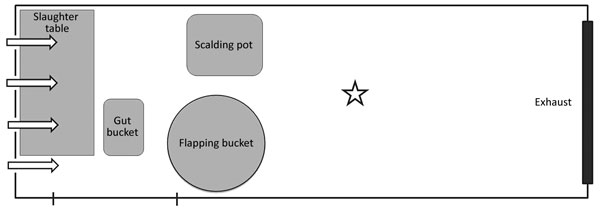Volume 23, Number 11—November 2017
Research
Airborne Transmission of Highly Pathogenic Influenza Virus during Processing of Infected Poultry
Figure 1

Figure 1. Processing area for study of airborne transmission of highly pathogenic influenza virus during processing of infected poultry. The star represents the location of the air sampler (experiment 1) or the naive hosts (experiment 2). The arrows indicate the airflow within the HEPA enclosure. The enclosure was 1.5 m wide × 6.7 m long × 2.1 m high, with 8.3 air changes/h (340 m3/h) and a velocity of 0.046 m/s.
1Current affiliation: Animal and Plant Quarantine Agency, Gimcheon-si, South Korea.
Page created: October 26, 2017
Page updated: October 26, 2017
Page reviewed: October 26, 2017
The conclusions, findings, and opinions expressed by authors contributing to this journal do not necessarily reflect the official position of the U.S. Department of Health and Human Services, the Public Health Service, the Centers for Disease Control and Prevention, or the authors' affiliated institutions. Use of trade names is for identification only and does not imply endorsement by any of the groups named above.